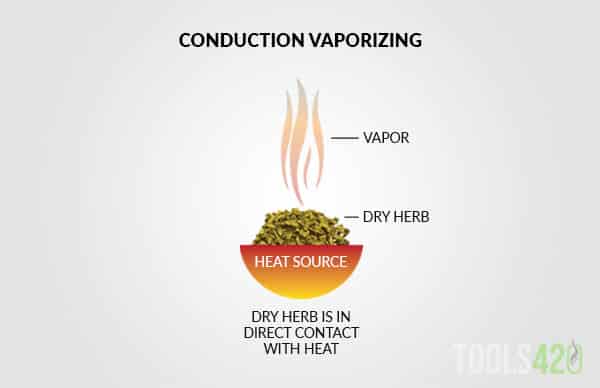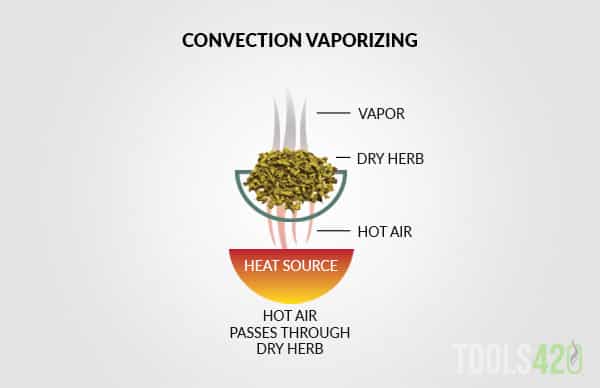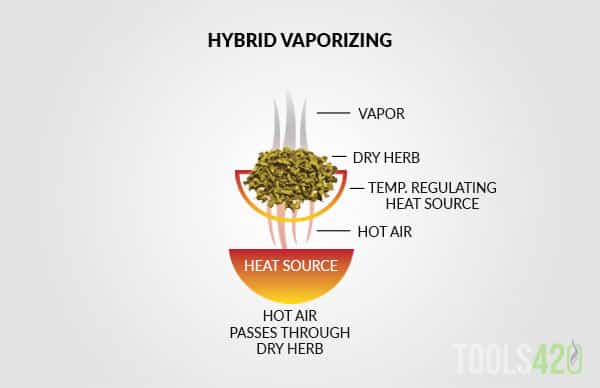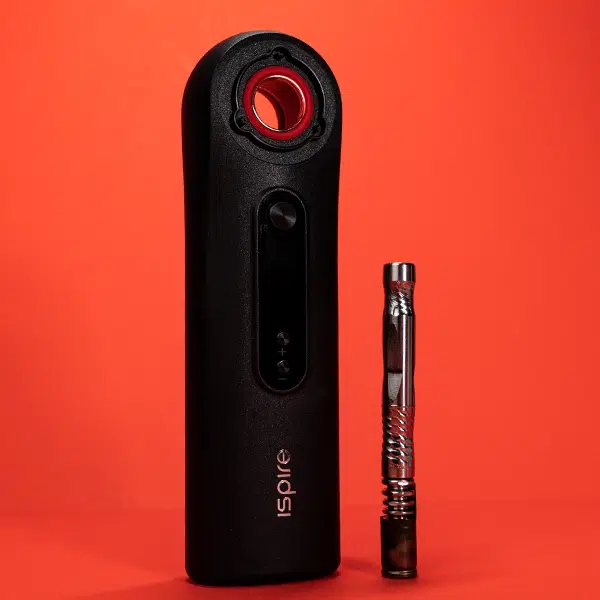Contents
Convection vs Conduction vape
You’ve probably seen dry herb vaporizers referred to as ‘conduction’ or ‘convection’ units, or even having ‘hybrid’ heating – What does this all mean?
Well, this blog will help to disambiguate the different kinds of vaporizer heating so that you can easily understand the differences between conduction, convection, and hybrid dry herb vapes! You can also check out our in-depth video covering all the differences.
What is a conduction dry herb vaporizer?
When you place your food on the frying pan, it’s heated via direct conduction. The same goes for cannabis inside your chamber. The flower is heated by the (usually) ceramic element and brought up to temperature by the transfer of heat.

This tech is very easy to implement, cost-effective, and thus many budget dry herb vapes use a conduction heating element. Examples would be the Utillian 421 and Flowermate Slick. Not all conduction herb vapes are cheap though, as even the renowned Davinci IQ2 and Zeus ARC GT use conduction heating in a great way. Here are some key features of conduction heating:
- Applies heat directly with a stainless steel, ceramic, or quartz chamber
- Uses less battery but takes longer to heat up
- Requires more stirring and takes longer to vaporize your herbs
- Typically cheaper and seen in budget dry herb vapes
With that in mind, conduction doesn’t produce as tasty vapor and isn’t as efficient as it constantly cooks your herbs. Still, it can produce heavy hits and strong effects.
Conduction vapes prefer a tight pack and finely ground herb. This allows heat to transfer properly and cook your herb more evenly. Still, you’ll want to stir every few minutes for a full cook.
What is a convection herb vaporizer?
Think of a convection oven where hot air is surrounding and passing by the food. Same process goes for cannabis in your vaporizer. Examples of popular convection vapes would be the Boundless Tera and XMAX V3 Pro. A convection herb vaporizer uses convective (hot air) heating to warm up your herb and deliver you the cannabinoids when you inhale. People seemingly prefer convection vaping since it gives much better flavor, is much more efficient, and has a quicker heat-up time.

Most convection devices heat-up very quickly (less than 10 seconds), while conduction typically takes longer (~1 minute) to warm up. Convection devices are usually the most expensive type of vaporizer as the tech is expensive and difficult to implement.
- Has hot air pass through the herb
- Typically has quicker heat-up times and preserves flavor better
- Can often vaporize herbs quicker and give bigger hits
- A higher price point
Convection vapes prefer a loose, fluffy grind and pack. This is to allow for air to pass through the herb as effectively as possible. Tightly packed herb will prevent proper airflow, and convection vapes usually work better with the harder you hit them!
What is a hybrid dry herb vaporizer?
As you might have guessed, a hybrid combines both convection and conduction into one knockout blow. Offering advantages from both sides of the coin, hybrid vapes are now quite common and perform very well.
By both heating the bowl and passing hot air through your herb, hybrid heating gives great hits, nice flavor, and consistent results.

While it doesn’t taste quite as pure as full convection, the quality is still terrific and legendary vapes like the Mighty Plus and Utillian 620 show just how good hybrid heating is. Here’s some things you can expect from hybrid heating:
- Heats with conduction and convection
- Usually takes 30-60 seconds to warm up
- Offer the most consistent results
- Typically moderately priced
For the best performance with a hybrid vaporizer, you’ll want to grind medium and pack it in just a little. Not enough to hinder airflow but enough so the herb is a little pressed in. This will yield the best results.

Compressing the hybrid G Pen Elite 2 chamber a bit
What is vaporizer induction heating?
Seldom seen but extremely effective, induction heating uses electromagnetism to stimulate and warm up metal. This metal then heats your material and gives you your goodies.
Unfortunately, induction heating is held back by the sheer size of the assembly and only found on custom Dynavap induction heaters and a couple of other units like the Dr. Dabber Switch.

Butane torch dry herb vaporizers
The Dynavap, Sticky Brick series and a few other vapes use a flame to heat up the unit. Often by means of a portable butane torch, flame-powered vapes hit notoriously hard and offer great results. Consequently, there is a learning curve towards flame-powered vaporizers however it’s definitely worth it for those face-melting rips!
Conclusion
There you have it – our disambiguation of the whole conduction vs convection vs hybrid vapes fiasco. Hybrid and pure convection is typically the fan favorites, but all have great qualities about them.
Check out our list of the best portable dry herb vapes to see our top picks and what we choose first. If you have any questions drop them down below, we’re glad to help out.
Thanks for reading and catch you next time!

